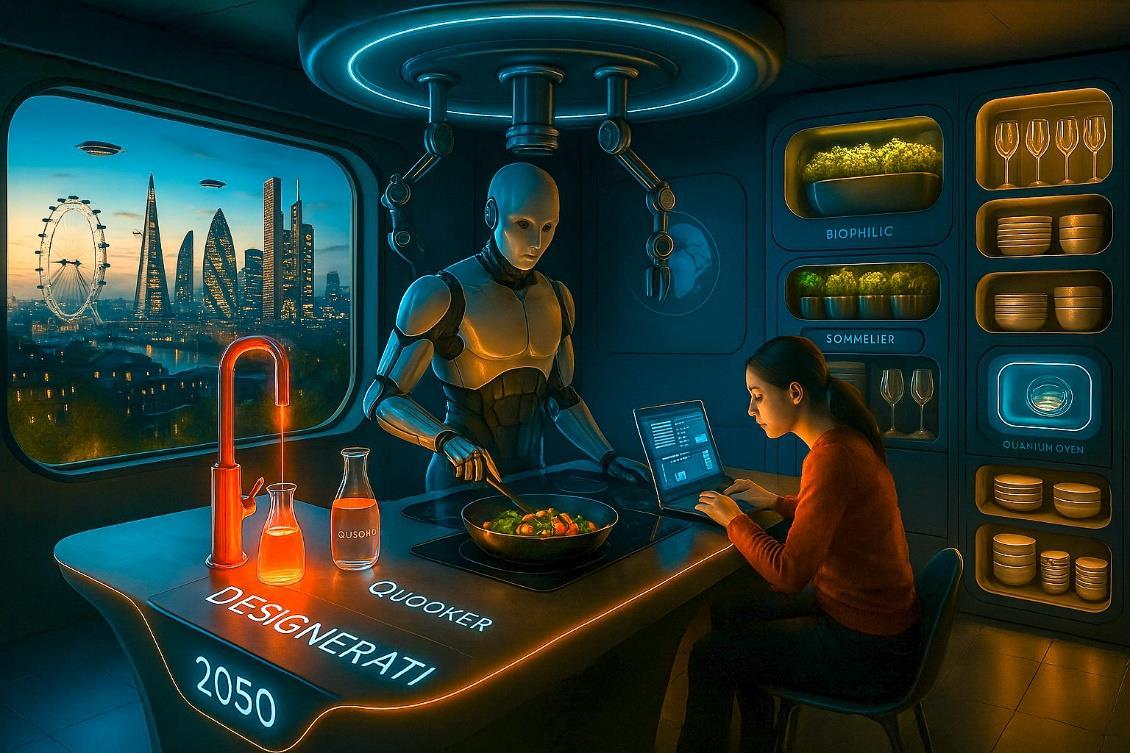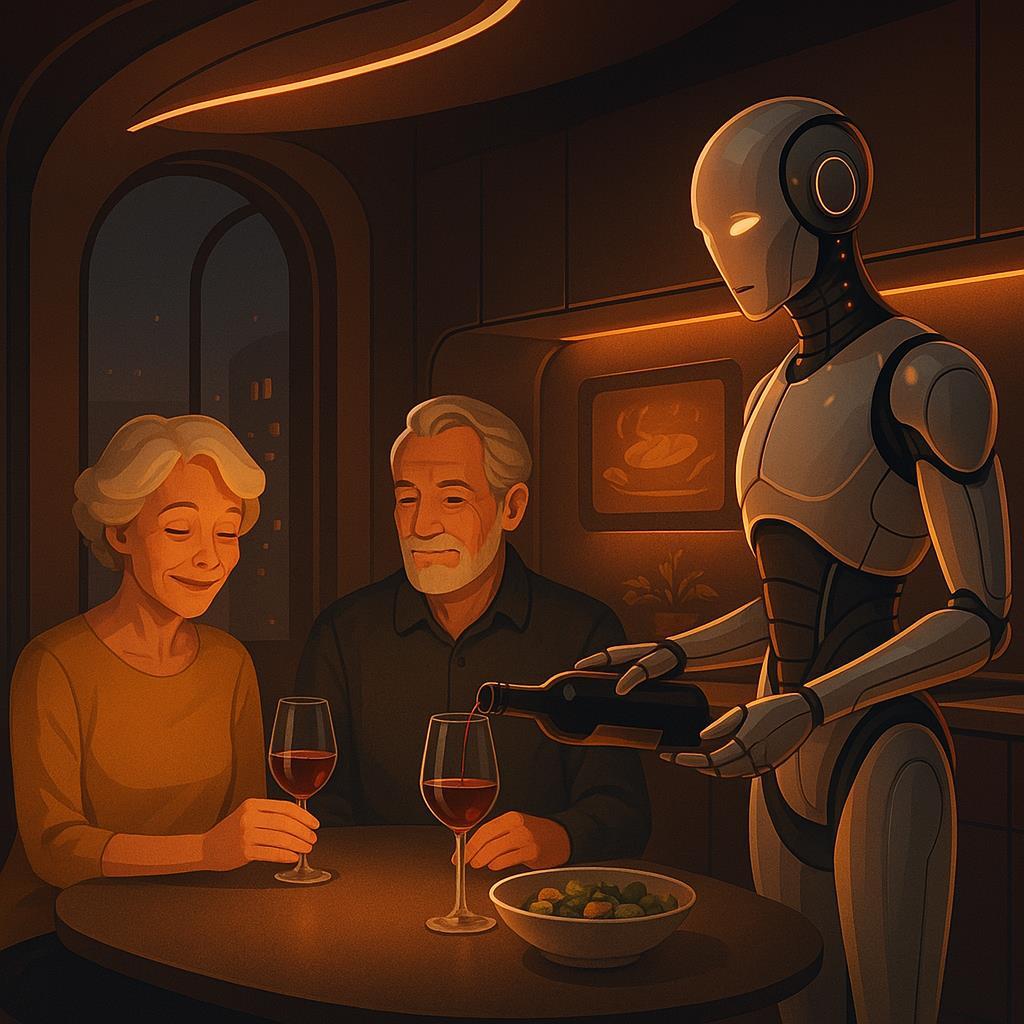

A designerati research project, in partnership with Quooker




A designerati research project, in partnership with Quooker

In 2050, the kitchen is no longer simply a room. It is a multi-sensory sanctuary, a responsive hub for health, sustainability, connection, and calm. With over 80% of the world’s population now living in cities many in micro-dwellings the future kitchen must do more than cook: it must nourish body, mind, and planet. This proposal presents a deeply considered response to that challenge, fusing visionary design, intelligent technology, and emotional resonance into a concept that feels as inevitable as it is innovative.


The housing crisis has reached a new inflection point. In the UK, 80% of 2050’s buildings already exist, many of them inefficient, ageing and unaffordable to first-time buyers. New housing is compact, energy-efficient, and increasingly modular. In this landscape, the kitchen must shrink in size but grow in function.


Our FutureKitchen proposal assumes a compact footprint part of a 2050 40m2 microapartment, optimised through spatial efficiency and powered by embedded AI. It combines multi-use furniture, concealed voice-activated technology, and fluid 3D-printed components that serve multiple roles worktop, herb garden, holographic control centre, or social table all within a single zone

Smart technology has become seamless by 2050 interfaces are ambient, not intrusive. The kitchen’s surface itself is now a control centre. The dining table doubles as a glassembedded touchscreen, displaying live nutrition data, holographic meal options, and community-sourced recipes.
An AI-enhanced android chef assistant manages prep, cooking, and even conversation if desired responding to verbal cues or biometric signals. Appliances are modular and cloud-connected, sharing energy loads with the building’s infrastructure and receiving overthe-air updates. The refrigerator is now an AI food concierge, scanning freshness levels, learning dietary preferences, and syncing with local indoor farms and food deliveries via drone.



The Quooker hot, cold, and boiling water tap is reinvented as a translucent nano plastic faucet with LED temperature rings, voice and facial recognition, and auto-dispensing, removing the need for physical touch. This version of the brand is promoted for the 80% of existing homes that continue to be upgraded to zero carbon energy standards in 2050. Quooker has also developed a version of their product that is incorporated integral to a multi-function free-standing FutureKitchen appliance hub. The hub comprises of a selfcontained movable tower with 5 culinary appliances that will form the basis of all domestic catering in 2050.


The FutureKitchen Hub has been developed by 5 of the leading 2050 appliance brands of this era primarily for use in new homes that continue to be built. With successive governments failing to meet their housing targets, and with vastly inflated costs to buy or rent in cities, new homes have become out of reach for many, and a housing crisis is prevalent. Microflats are now the main affordable living accommodation in cities.
The FutureKitchen Hub has been developed by the FutureKitchen group to address the issues of compact space in new homes, and the tower occupies a footprint of only 1 metre diameter and 2 metres high. Concealed wheels allow the hub to be positioned and plugged into different locations within the open plan kitchen, dining, and living zone. The Hub is available in several colours to harmonise with the palette of Microflat interior designs. The Hub unit is controlled from a holographic wall panel that displays “MENU 2050” with recipes tailored to each resident’s nutritional needs, allergies, and personal goals.




2050 is the age of mandatory circularity. Every kitchen system is closed loop. Food waste is separated, composted, and fed into domestic biodigesters that power micro-energy systems. A vertical biophilic herb garden not only freshens the air but grows organic microgreens, moss filters, and kitchen aromatics.
The kitchen structure itself uses biopolymer 3D-printed materials, derived from agricultural waste or recycled plastics. Units are designed to dematerialise fewer parts, more purpose with repairable modules and minimal fasteners.
Water is metered at the micron level. Appliances only activate when sensors detect need dynamic induction hobs that only heat beneath cookware, and dishwashing systems that use fog-cleaning nano-jets, recycling greywater into plant irrigation.

An ageing population demands more than just ‘accessible’ it demands dignified, intuitive, beautiful design. This kitchen adjusts itself to its users, not the other way around. Surfaces are height adaptive. Shelving systems rise and lower at a touch or voice command. Magnetic drawers open hands-free. Voice-activated lighting and cooking sequences remove barriers for those with reduced mobility.
AI systems use facial expressions, movement, and thermal scans to detect stress, fatigue, or physical discomfort adjusting lighting, temperature, or suggesting hydration breaks. The kitchen island becomes a wellness companion, guiding healthy routines subtly and supportively.


Nutrition in 2050 is hyper-personalised. The kitchen functions as a digital dietitian, supporting goals like gut health, brain clarity, or longevity. Embedded nutrient scanners read the molecular content of produce and recommend combinations tailored to the occupant’s genetics or real-time health markers.
Yet, while data drives decisions, the kitchen also restores ritual. Digital minimalism is embraced. Notifications are subtle, embedded into light pulses or gentle soundscapes. Aromatherapy from the herb garden augments mood. A warm glass of red wine shared with an android server is as valued as a drone-delivered supplement smoothie. The Future Kitchen is a place of joy, not just fuel.


The material palette merges natural tactility with digital responsiveness. Countertops are grown using mycelium composites. Floors incorporate piezoelectric tiles that convert footsteps into energy. Cabinetry is made from carbon-negative hemp board with metallic lichen inlays.
Smart materials shift colour and texture based on mood or use. A backsplash glows warmer during mealtimes and cools to a calming hue post-dinner. Cabinet facades contain OLED membranes that display icons or vanish to reveal the interiors light without glare.
The palette blends deep matte blacks and soft yellows, reflecting both heritage and optimism, and referencing the Designerati 2025 colours as a nod to the design continuum from present to future.

The Future Kitchen’s visual language is fluid, curvilinear, and emotionally intelligent. 3D printing enables free-form cabinetry inspired by nature like roots, waves, and honeycombs offering storage without hard corners. Curved panoramic windows frame London’s transformed skyline, allowing daylight to flood in and AI-calibrated circadian lighting to take over at dusk.
Biophilic planting from trailing vines to edible flowers creates a living artwork, a reminder of natural rhythms and food origins. LED accents, such as “Live Well” and “Designerati” embedded into cabinetry, reinforce a positive mindset and connection to community and care.

What sets this vision apart is not just the innovation but the emotional intelligence embedded in the experience. This is a kitchen that remembers birthdays, dims lights for romance, suggests nostalgic dishes from a user’s cultural past, and even adapts based on sensory mood input.
It’s a kitchen where a couple in their later years can enjoy a beautiful, nourishing meal, poured lovingly by an android who knows their favourite vintage. It’s where ageing isn’t feared it’s celebrated. Technology enhances presence, not distraction.

In 2050, kitchens are no longer fitted units in a room. They are adaptive ecosystems, shaped around our changing needs personal, planetary, and emotional. They help us live better, with less. They regenerate our homes, our habits, and our health.
This submission captures that vision with depth, optimism, and realism. From intelligent wine service to futuristic food prep, from ageing-in-place dignity to design-for-delight, the FutureKitchen is more than a concept. It’s a manifesto for how we might choose to live and age beautifully.
